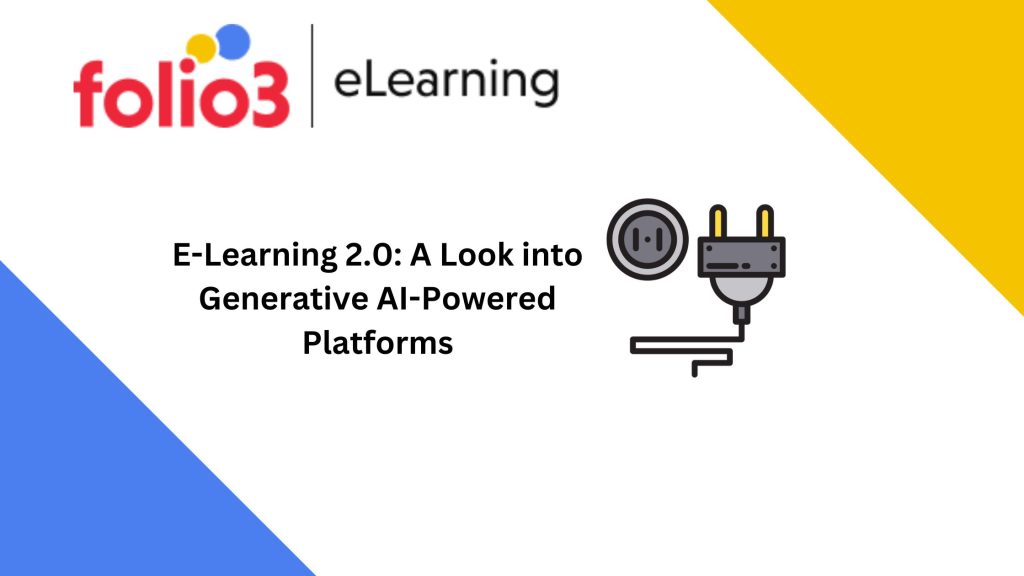
Executive Summary:
E-Learning 2.0 is being made possible by the change caused by generative AI in the e-learning industry. This game-changing technology is transforming education by making it more personalized and effective through Generative AI-powered platforms.
Introduction:
Education is changing in a time of fast technological growth. Digital platforms are replacing traditional methods, and generative AI has emerged as a game-changer in this transformation.
A branch of artificial intelligence called “generative AI” is concerned with independently producing material. Generative AI in e-learning can create text, images, videos, and even whole courses.
Utilizing this technology, educational platforms that are incredibly dynamic, adaptable, and tailored to each learner’s requirements and preferences are being created.

Generative AI in E-Learning: Understanding Potential
Generative AI in e-learning is the key to personalizing instructional information to each student’s specific needs, transforming conventional one-size-fits-all methods.
Generative AI in e-learning is stepping into a new era of personalized, dynamic, and engaging education.
- Adaptive and Dynamic Content
Since generative AI is dynamic, learning materials can be continuously modified and updated. AI has the ability to rapidly incorporate the most recent facts and advances into the curriculum, in contrast to static textbooks or courses that could grow out of date over time.
This promotes a culture of lifelong learning by ensuring that students are always exposed to the most current and relevant information. Furthermore, because AI is adaptive, it may change the content’s level of difficulty in response to how well a student is doing.
This prevents students from getting frustrated by difficult material or bored by overly simple material.
- Increasing Engagement with Multimedia
The capabilities of generative AI go beyond text-based learning. It has the capacity to produce a wide variety of multimedia material, including gamified exercises, virtual reality experiences, interactive simulations, and 3D models.
These multimedia components increase learning retention and engagement. Students can virtually dissect a frog or study the human circulatory system in three dimensions in science class, for instance.
They can fully engross themselves in a virtual setting where they must communicate in the target language during language classes. Such immersive learning opportunities increase engagement and motivation in addition to understanding.
- On-Demand Content Generation
Generative AI makes it possible to produce on-demand educational materials. AI can produce the content required to enable upskilling at any moment, whether it’s a brief video tutorial, an engaging quiz, or a thorough course.
In order to maximize the effectiveness of their learning process, learners can access the most pertinent information exactly when they need it thanks to this flexibility.
Keeping up with new trends and tools is essential in fast-paced areas like technology and digital marketing. Learners will get quick access to learning materials about the most recent developments thanks to generative AI.
By keeping professionals educated and equipped to meet new problems, this timeliness helps them stay competitive in their areas.
- Real-World Application
Learners who can put their new skills to use in real-world situations will benefit most from ongoing upskilling. Practical exercises, case studies, and simulations that let people hone their newly learned abilities in a risk-free setting can be produced using generative AI.
The knowledge acquired is not only theoretical but also applicable in practical contexts thanks to this application-oriented approach. With the help of generative AI, it is possible to build simulations and scenarios that accurately reflect the difficulties and complexities of a given sector or profession.
For instance, it can be used in the healthcare industry to imitate patient instances so that doctors can diagnose and treat patients. It can be used to simulate decision-making situations in business management, where students must make strategic decisions.
- Collaborative Learning Environments
Through generating group projects, questions for discussion, and engaging group activities, generative AI can support collaborative learning.
It can even create AI-driven virtual teammates that behave like people, promoting communication and teamwork skills. These cooperative educational opportunities prepare pupils for real-world situations where cooperation is necessary.
Group projects can be created and assigned by generative AI that are in line with the course’s learning objectives. It makes sure that each team member may participate in a significant way by taking into consideration the talents and weaknesses of individual students to establish teams that are balanced.
Additionally, AI can recommend project subjects that are pertinent to students’ hobbies or career goals, boosting motivation and engagement.
Conclusion:
Generative AI-Powered Platforms enables students to precisely map their educational route, ensuring that no challenge is fulfilled, no question is left unanswered, and no skill is left unmastered.
It upholds the concepts of inclusion and accessibility, ensuring that everyone may access high-quality education, regardless of background or ability. It encourages ongoing skill development, allowing people to remain competitive and adaptive in a workplace that is constantly changing.
Education is changing, and generative AI in e-learning is leading the way on this fascinating adventure.
Responsible use of these innovations will surely result in a better and more accessible future for students all over the world. A new era of personalized, effective, and engaging education is being ushered in by generative AI-powered platforms in E-Learning.





